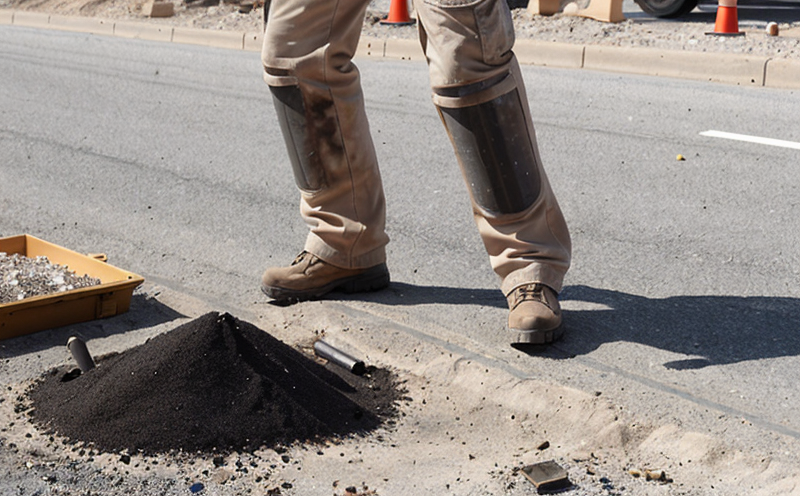ASTM E1449 Sensitivity of Explosives to Drop Weight Impact Testing
The ASTM E1449 sensitivity test evaluates the resistance of explosives and blasting materials to impact. This test is crucial for ensuring safety in mining operations, where accidental detonations can lead to catastrophic failures with severe consequences. The test measures how much mechanical energy is required to cause an explosion or detonation by dropping a calibrated weight from varying heights onto the explosive sample.
The methodology involves placing the sample under a precisely controlled setup and subjecting it to impact forces generated by dropping weights of specific sizes and masses from different heights. The height from which the weight is dropped can be adjusted according to the sensitivity class of the explosive being tested, ranging from Class 1 (most sensitive) to Class 5 (least sensitive).
The test apparatus includes a drop hammer with a known mass that strikes the sample. The apparatus also ensures that the impact force is transmitted uniformly across the sample’s surface area. The sample size and shape are standardized based on the type of explosive being tested, ensuring consistent testing results.
Testing parameters such as weight, height, and energy input are closely monitored to ensure reproducibility. The test aims to determine the minimum amount of mechanical impact necessary for a sample to detonate or explode. This information is critical for manufacturers, regulatory bodies, and end-users to understand the safety margins associated with the explosive materials.
The ASTM E1449 test not only ensures compliance with international standards but also provides valuable data that can be used in refining new formulations of explosives and improving their performance characteristics without compromising on safety. This testing procedure is essential for ensuring that blasting operations are conducted safely, minimizing risks to personnel and infrastructure.
Understanding the sensitivity of explosive materials through ASTM E1449 helps prevent accidents by providing detailed insights into how these materials behave under specific stress conditions. The test results can be used in various sectors including mining, construction, quarrying, and demolition, where controlled explosions are a necessary part of the process.
The test also plays a crucial role in the research and development phase of new explosive formulations by providing data that informs improvements in chemical composition, manufacturing processes, and safety features. By understanding how different factors affect sensitivity, manufacturers can design safer products while maintaining effective performance.
Why Choose This Test
The ASTM E1449 sensitivity test is a vital tool for quality managers, compliance officers, R&D engineers, and procurement teams involved in the mining sector. Choosing this test ensures that all blasting materials meet stringent safety standards and are fit for purpose.
- Ensures Compliance: This test aligns with international standards such as ASTM E1449, ensuring compliance with regulatory requirements.
- Enhances Safety: By determining the sensitivity of blasting materials to impact forces, this test helps prevent accidental detonations and ensures safer mining operations.
- Informs Product Development: The test data can be used in R&D to improve explosive formulations and enhance their safety margins without compromising on performance.
- Supports Quality Control: Regular testing allows for consistent quality assurance, ensuring that all materials meet the required standards before being used in mining operations.
The test also provides a competitive edge by ensuring that your organization is at the forefront of safety and compliance practices. This can be particularly advantageous when bidding on contracts or securing regulatory approvals.
Environmental and Sustainability Contributions
- Eco-Friendly Materials: The use of ASTM E1449 helps in selecting materials that are less likely to cause environmental damage, contributing positively to sustainability efforts.
- Safe Handling Practices: By ensuring the safe handling and transport of explosives, this test minimizes risks associated with accidental detonations, which can lead to pollution or habitat destruction.
- Resource Efficiency: The data obtained from this test aids in optimizing explosive use, thereby reducing waste and increasing resource efficiency.
The ASTM E1449 sensitivity test not only ensures safety but also supports broader sustainability goals by promoting responsible practices throughout the mining sector. By minimizing risks and enhancing operational safety, this test contributes to a more sustainable future for mining operations.
Competitive Advantage and Market Impact
The ASTM E1449 sensitivity test provides significant competitive advantages in several ways:
- Regulatory Compliance: Ensuring compliance with international standards can open doors to new markets and reduce the risk of regulatory fines.
- Enhanced Safety Reputation: Demonstrating a commitment to safety through rigorous testing can build trust and enhance your reputation in the industry.
- Innovation Leadership: By incorporating this test into your R&D processes, you can stay ahead of competitors by continuously improving product safety and performance.
The market impact of this test is profound. It ensures that all blasting materials used meet strict safety standards, which not only protects workers but also reduces the risk of environmental damage. This contributes to a safer and more sustainable mining industry, ultimately leading to increased customer satisfaction and loyalty.





